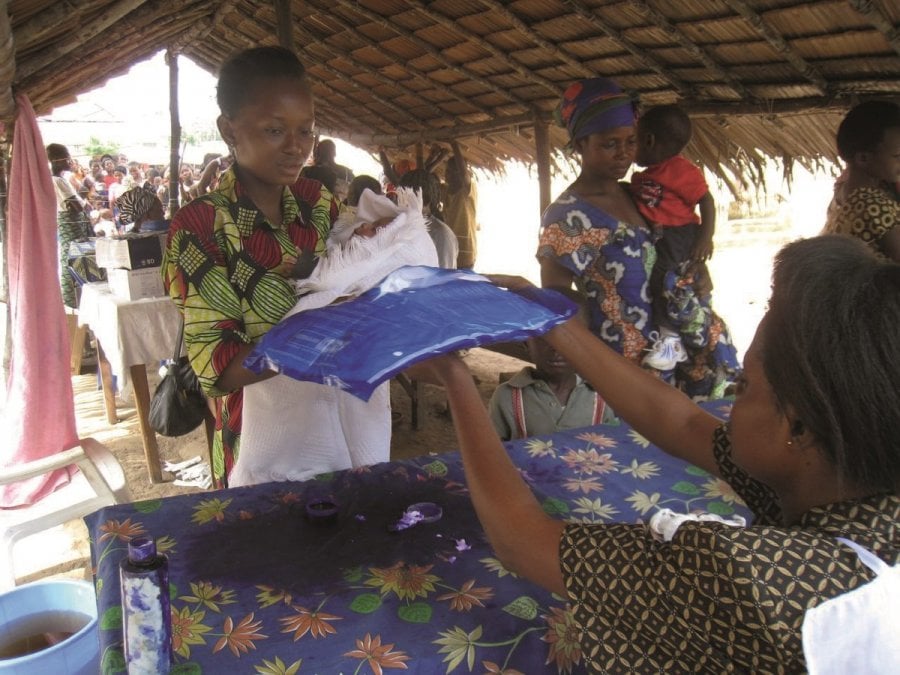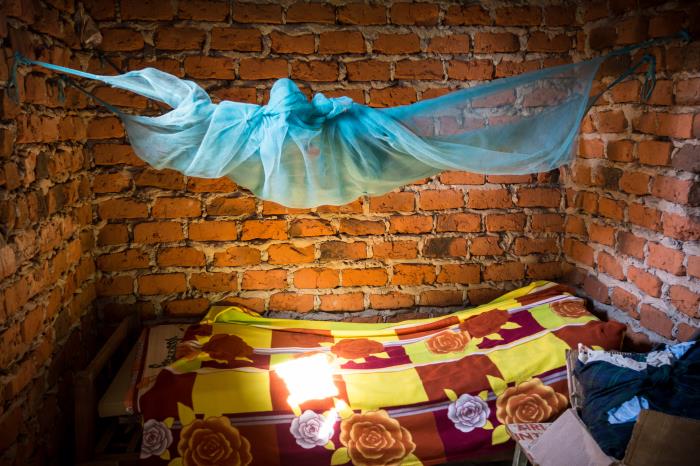
Twenty years of comprehensive research by LSHTM into long-lasting insecticidal nets (LLINs) and indoor residual spraying of houses have contributed substantially to the prevention of 1.3 billion fewer malaria cases and 6.8 million fewer malaria-related deaths attributable to malaria prevention since the millennium. Before the Malaria Centre, LSHTM was already established as a leading player in development of insecticide treated nets (ITNs), the forerunner of LLINs. By 1993, the first major field trial of ITN in Africa (in The Gambia) by Brian Greenwood, Steve Lindsay and Pedro Alonso had shown the first large reduction in all-cause child mortality; and replication of trials in the 1990s by Christian Lengeler, Peter Smith and country researchers in Ghana, Burkina Faso, Kenya and justified the large-scale role out across the range of eco-epidemiological conditions found in Africa. More globally, trials in South Asia, the Amazon basin, and SE Asia demonstrated that ITN were effective against both falciparum and vivax malaria, and together with the African trials culminated in an influential meta-analysis and Cochrane review recently updated. Supporting evidence gathered by Goodman, Mills and country economists, showing that ITNs were very cost-effective, are described elsewhere in this series.
Also during 1990s, small-scale trials in Tanzania demonstrated the entomological mode of action of ITNs, by recording reductions in mosquito density and sporozoite rates. This confirmed the underlying mechanism of the ‘mass population effect’ which occurs when the insecticide kills so many mosquitoes that the transmission capacity of the local mosquito population is reduced, protecting the whole community rather than just the individual net user.
At the turn of the millennium, when resources for malaria control were more limited than now, there was heated debate between those who argued in order to obtain the levels of coverage necessary to achieve the mass effect and community protection, nets should be distributed free of charge to everyone versus others who sought to attain high coverage by diversifying the channels of distribution, encouraging sustainable commercial markets and promoting selective subsidies to those most in need.
LSHTM researchers conducted a series of detailed studies to examine the role of local commercial markets in delivering mosquito nets to end users, and showed that the coverage achieved by commercial markets in nets is more equitable than that achieved by the sale of subsidised nets by public health systems and projects. Further work in 2010–2011 demonstrated the epidemiological advantages of free distribution of nets directly to pregnant women and infants through routine antenatal and immunisation services.
The millennium marked the advent of the LLIN, nets which do not require annual retreatment to retain their insecticidal efficacy. In 2001–2004, Malaria Centre entomologists undertook a multicentre study in 3 countries testing different methods of washing LLINs and comparing their performance. This showed that the prototype LLIN, PermaNet 1.0, varied in its wash resistant according to production batch, but that the successor, PermaNet 2.0, would readily withstand multiple washes. This landmark study marked the beginning of standardised evaluation of LLIN and quality control of LLIN production. Upon this, LSHTM entered into strategic partnership with WHO to develop more rigorous criteria for evaluating the brands of LLINs which were starting to enter the market. The methods of LLIN field evaluation co-developed by LSHTM are described in the WHO Guidelines for Laboratory and Field Testing of Long-lasting Insecticidal Nets, shortly to enter its 3rd edition. Central to LLIN development and evaluation are experimental hut studies, small scale studies where volunteers sleep under the candidate net in special huts under controlled conditions in which the proportion of mosquitoes killed by the LLIN can be measured precisely.
This approach has served WHO well for comparing and approving new brands of LLIN to standardized criteria and over a dozen LLIN tested in this way by LSHTM and partners in East and West Africa are now vying for the market.
In 2002-2007, further experimental hut research in West Africa was carried out in response to the discovery that insecticide resistant genes in mosquito vectors were spreading rapidly. This comparative research in areas of high pyrethroid resistance and susceptibility in southern, and northern Benin respectively, was the first to provide clear and conclusive evidence that resistance does reduce the entomological effectiveness and personal protection among users of ITNs. Parallel entomological studies in ordinary households in the two locations confirmed the findings. The topic remains a controversial one: in some places, standard LLIN remain partially protective against malaria transmitted by resistant vectors, as indicated in a multi-country studyin Africa and Asia as recently as 2016-2017. Mojca Kristan has produced intriguing evidencethat exposure to pyrethroid on nets that are sub-lethal to resistant mosquitoes can interfere with parasite development and may prevent malaria transmission.
In the 1990s, methods of responding to, or preventing, the emergence of pyrethroid resistance in Anopheline vectors was studied, and concluded that deploying mixtures of dissimilar insecticides on bed nets was among the most promising strategies. Recognising the grave threat that resistance presented to the future of pyrethroid LLIN and the long lead time required to develop new safe and effective alternatives, Malaria Centre researchers supported by the Gates Malaria Partnership, joined in strategic partnership with WHO and pesticide and textile industry in 2002 to identify and test new active ingredients for nets. By the time WHO had launched the Global Plan for Insecticide Resistance Management in 2012, the development and evaluation of LLIN products containing insecticide combinations was already well advanced and included a new type of LLIN, the PBO-pyrethroid LLIN, which contained a chemical synergist to neutralise metabolic resistance. While the entomological efficacy of PBO synergist LLIN over pyrethroid-only LLIN was indicated by experimental hut studies as early as 2008, uptake of PBO-LLIN by national malaria control programmes has remained slow over the last decade due to the extra cost entailed. In order to demonstrate the added benefit and protection of PBO-pyrethroid LLIN, more rigorous evidence was sought, akin to the malaria control trials of twenty years previously which heralded the advantages of ITNs at that time. A cluster randomised trial conducted in NW Tanzania 2015-2017 demonstrated that PBO LLIN reduces malaria infection prevalence by a further 44% compared to standard pyrethroid LLIN for over two years. With this evidence, WHO in 2017 recommended PBO-pyrethroid LLIN as a new product class to control malaria transmitted by pyrethroid resistant vectors, to which the Global Fund and President’s Malaria Initiative have responded by placing country orders in 2018.
Development of alternative insecticides to use on LLINs has continued apace. The capacity of pyrrole (chlorfenapyr), oxadiazine (indoxacarb) and pyriproxifen classes to control pyrethroid resistant vectors in laboratory and experimental hut trials was identified. Through the Innovative Vector Control Consortium (IVCC) and its support to chemical industry to develop new classes of LLIN, LSHTM has become their key partner on LLIN development and evaluation. Long-lasting mixture LLIN combining pyrethroid with chlorfenapyr (Interceptor G2) or pyriproxifen (Olyset Duo, Royal Guard) have been developed iteratively over the last ten years and evaluated rigorously in WHO Phase 1 (laboratory) and Phase 2 (experimental hut) trials over multiple washes at the PAMVERC/LSHTM field trial sites in Benin, Tanzania and Ivory Coast. Epidemiological evidence that these products give improved malaria control effect over standard LLIN, as now required by WHO and international control agencies, are in progress in Tanzania and Benin, through cluster randomised trials led by Protopopoff and supported by Rowland, Cook, Kleinschmidt and Ngufor. These will form the next generation of LLIN to further malaria control.
LSHTM's short courses provide opportunities to study specialised topics across a broad range of public and global health fields. From AMR to vaccines, travel medicine to clinical trials, and modelling to malaria, refresh your skills and join one of our short courses today.

